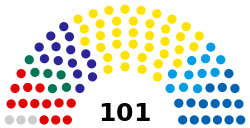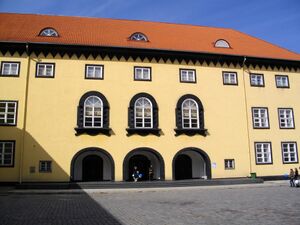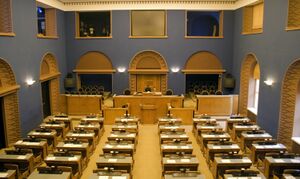برلمان إستونيا
State Assembly of Estonia Riigikogu | |
|---|---|
| XV Riigikogu | |
 | |
| النوع | |
| النوع | |
| التاريخ | |
| تأسس | 23 أبريل 1919 |
| انحل | 1940–1991 |
| الزعامة | |
الرئيس | |
First Vice-Chairman | |
Second Vice-Chairman | |
| الهيكل | |
| المقاعد | 101 |
 | |
المجموعات السياسية | Government (65)
Opposition (36)
|
| اللجان | |
| الانتخابات | |
| Party-list proportional representation Modified D'Hondt method | |
آخر انتخابات | 5 March 2023 |
الانتخابات المقبلة | By 7 March 2027 |
| مكان الانعقاد | |
 | |
| Parliament building in Toompea Castle, Tallinn | |
| الموقع الإلكتروني | |
| www.riigikogu.ee | |
ريگيكوگو ( Riigikogu من الإستونية riigi-, "of the state", and kogu, "assembly") is the unicameral parliament of Estonia. In addition to approving legislation, the Parliament appoints high officials, including the prime minister and chief justice of the Supreme Court, and elects (either alone or, if necessary, together with representatives of local government within a broader electoral college) the president. Among its other tasks, the Riigikogu also ratifies significant foreign treaties that impose military and proprietary obligations and bring about changes in law, as well as approves the budget presented by the government as law, and monitors the executive power.
التاريخ
 |
|---|
|
|
23 April 1919, the opening session of the Estonian Constituent Assembly is considered the founding date of the Parliament of Estonia.[1] Established under the 1920 constitution, the Riigikogu had 100 members elected for a three-year term on the basis of proportional representation. Elections were fixed for the first Sunday in May of the third year of parliament.[2] The first elections to the Riigikogu took place in 1920. From 1923 to 1932, there were four more elections to the Riigikogu. The elections were on a regional basis, without any threshold in the first two elections, but from 1926 a moderate threshold (2%) was used. The sessions of the Riigikogu take place in the Toompea Castle, where a new building in an unusual Expressionist style was erected in the former courtyard of the medieval castle in 1920–1922.
In 1933 amendments to the first Constitution was approved by referendum, where more power was given to an executive President. The following year, the President used these new powers to adjourn parliament and declared martial law to avert an alleged coup.[3] In 1937, a second constitution was approved by referendum which saw the introduction of a two chambered legislature, the Chamber of Deputies (Riigivolikogu) and the National Council (Riiginõukogu). Elections were subsequently held in 1938 where only individual candidates were allowed to run.
During the subsequent periods of Soviet occupation (1940–41), German occupation (1941–44), and the second Soviet occupation (1944–1991) the Parliament was disbanded. The premises of the Riigikogu were used by the Supreme Soviet of the Estonian SSR during the second Soviet occupation.
استعادة الاستقلال
In September 1992, a year after Estonia had regained its independence from the Soviet Union, elections to the Parliament took place on the basis of the third Constitution of Estonia adopted in a referendum in the summer of the same year. The 1992 constitution, which incorporates elements of the 1920 and 1938 Constitutions and explicitly asserts its continuity with the Estonian state as it existed between 1918 and 1940, sees the return of a unicameral parliament with 101 members. The most recent parliamentary elections were held on 5 March 2023. The main differences between the current system and a pure political representation, or proportional representation, system are the established 5% national threshold, and the use of a modified D'Hondt formula (the divisor is raised to the power 0.9). This modification makes for more disproportionality than does the usual form of the formula.
أحدث انتخابات
2023 Estonian parliamentary election
توزيع المقاعد الحالي
The seat allocation refers to de facto allocation, as defectors from fractions are not allowed to join other ones between elections.
- Reform Party 38
- زعيمة الحزب: كايا كالاس
- Social Democratic Party of Estonia 14
- party leader: Lauri Läänemets
- Estonia 200 13
- party leader: Margus Tsahkna
- Conservative People's Party of Estonia 11
- party leader: Martin Helme
- Isamaa 11
- party leader: Urmas Reinsalu
- Centre Party 6
- party leader: Mihhail Kõlvart
- Independents 8
Structure of former legislatures
Estonian Parliament after 1992 election
| 29 | 17 | 15 | 12 | 10 | 8 | 8 | 1 | 1 |
| Isamaa | Safe Home | Popular Front | Moderates | Independence | ERP | Citizen | Greens | EEE |
Estonian Parliament after 1995 election
| 41 | 19 | 16 | 8 | 6 | 6 | 5 |
| Coalition/Country | Reform | Centre | RKEI and ERSP | Moderates | Home | Right |
Estonian Parliament after 1999 election
| 28 | 18 | 18 | 17 | 7 | 7 | 6 |
| Centre | Pro Patria | Reform | Moderates | Coalition | Country | United |
Estonian Parliament after 2003 election
| 28 | 28 | 19 | 13 | 7 | 6 |
| Centre | Res Publica | Reform | People's Union | Pro Patria | Moderates |
Estonian Parliament after 2007 election
| 31 | 29 | 19 | 10 | 6 | 6 |
| Reform | Centre | IRL | SDE | Greens | People's Union |
Estonian Parliament after 2011 election
| 33 | 26 | 23 | 19 |
| Reform | Centre | IRL | SDE |
Estonian Parliament after 2015 election
| 30 | 27 | 15 | 14 | 8 | 7 |
| Reform | Centre | SDE | IRL | EVA | EKRE |
Estonian Parliament after 2019 election
| 34 | 26 | 19 | 12 | 10 |
| Reform | Centre | EKRE | Isamaa | SDE |
Estonian Parliament after 2023 election
| 37 | 17 | 16 | 14 | 9 | 8 |
| Reform | EKRE | Centre | E200 | SDE | Isamaa |
Speakers of the Riigikogu
The salary of the speaker is €8318.19 per month.[4]
1921–1937
| Name | Period | Legislature |
|---|---|---|
| Otto Strandman | 4 January 1921 – 18 November 1921 | I Riigikogu[5] |
| Juhan Kukk | 18 November 1921 – 20 November 1922 | I Riigikogu[5] |
| Konstantin Päts | 20 November 1922 – 7 June 1923 | I Riigikogu[5] |
| Jaan Tõnisson | 7 June 1923 – 27 May 1925 | II Riigikogu[5] |
| August Rei | 9 June 1925 – 22 June 1926 | II Riigikogu[5] |
| Karl Einbund | 22 June 1926 – 19 July 1932 | III Riigikogu, IV Riigikogu, V Riigikogu[5] |
| Jaan Tõnisson | 19 July 1932 – 18 May 1933 | V Riigikogu[5] |
| Karl Einbund | 18 May 1933 – 29 August 1934 | V Riigikogu[5] |
| Rudolf Penno | 28 September 1934 – 31 December 1937 | V Riigikogu[5] |
Speakers of the Riigivolikogu (lower chamber)
| Name | Period | Legislature |
|---|---|---|
| Jüri Uluots | 21 April 1938 – 12 October 1939 | VI Riigikogu[5] |
| Otto Pukk | 17 October 1939 – 5 July 1940 | VI Riigikogu[5] |
| Arnold Veimer | 21 July 1940 – 25 August 1940 |
Speaker of the Riiginõukogu (upper chamber)
| Name | Period | Legislature |
|---|---|---|
| Mihkel Pung | 21 April 1938 – 5 July 1940 | VI Riigikogu[5] |
Chairman of the Supreme Council (1990–1992)
| Name | Period |
|---|---|
| Arnold Rüütel | 29 March 1990 – 5 October 1992 |
Speaker of the Supreme Council (1990–1992)
| Name | Period |
|---|---|
| Ülo Nugis | 29 March 1990 – 5 October 1992 |
Since 1992
| Name | Period | Legislature |
|---|---|---|
| Ülo Nugis | 21 October 1992 – 21 March 1995 | VII Riigikogu[5] |
| Toomas Savi | 21 March 1995 – 31 March 2003 | VIII Riigikogu, IX Riigikogu[5] |
| Ene Ergma | 31 March 2003 – 23 March 2006 | X Riigikogu[5] |
| Toomas Varek | 23 March 2006 – 2 April 2007 | X Riigikogu[5] |
| Ene Ergma | 2 April 2007 – 20 March 2014 | XI Riigikogu, XII Riigikogu[5] |
| Eiki Nestor | 20 March 2014 – 4 April 2019 | XII Riigikogu, XIII Riigikogu[5] |
| Henn Põlluaas | 4 April 2019 – 18 March 2021 | XIV Riigikogu[5] |
| Jüri Ratas | 18 March 2021 – 10 April 2023 | XIV Riigikogu[5] |
| Lauri Hussar | 10 April 2023 – present | XV Riigikogu[6] |
Chancellery
This section requires expansion. (March 2020) |
Established on October 5 of 1992, the Chancellery of the Riigikogu (الإستونية: [Riigikogu Kantselei] Error: {{Lang}}: text has italic markup (help)) is the administration supporting the Riigikogu in the performance of its constitutional functions.[7] The departments of the Chancellery perform the daily functions.
See also
- List of members of the Parliament of Estonia
- Chairman of the Supreme Soviet of the Estonian Soviet Socialist Republic
Citations and references
- ^ "Riigikogu". Riigikogu. Archived from the original on 5 December 1998. Retrieved 17 December 2018.
- ^ Miljan 2004, p. 413.
- ^ Miljan 2004, p. 414.
- ^ "Salaries of MPS".
- ^ أ ب ت ث ج ح خ د ذ ر ز س ش ص ض ط ظ ع غ ف "Riigikogu juhatus". Riigikogu. Archived from the original on 6 June 2015. Retrieved 18 June 2019.
- ^ "Eesti 200 leader Lauri Hussar elected Riigikogu speaker". ERR (in الإنجليزية). 10 April 2023.
- ^ "Chancellery of the Riigikogu". Riigikogu (in الإستونية). Archived from the original on 6 April 2020. Retrieved 21 March 2020.
Cited sources
- Miljan, Toivo (2004). Historical Dictionary of Estonia (in الإنجليزية). Maryland, US: Scarecrow Press. ISBN 0-8108-4904-6.
External links
- Official website

- Riigkogu's election law (in إنگليزية)
59°26′09″N 24°44′14″E / 59.43583°N 24.73722°E
خطأ لوا في وحدة:Authority_control على السطر 278: attempt to call field '_showMessage' (a nil value).
- CS1 الإستونية-language sources (et)
- Pages using gadget WikiMiniAtlas
- Short description is different from Wikidata
- Portal-inline template with redlinked portals
- Pages with empty portal template
- Articles with hatnote templates targeting a nonexistent page
- Articles to be expanded from March 2020
- All articles to be expanded
- Lang and lang-xx template errors
- Articles with إنگليزية-language sources (en)
- Coordinates not on Wikidata
- Riigikogu
- 1919 establishments in Estonia
- Government of Estonia
- National legislatures
- Parliaments by country
- Unicameral legislatures

